
Scutus is a genus of large sea snails or limpets with the common name "shield shells". These are marine gastropod molluscs in the family Fissurellidae, the keyhole limpets and slit limpets.

Calymene Brongniart, 1822, is a genus of trilobites in the order Phacopida, suborder Calymenina, that are found throughout North America, North Africa, and Europe in primarily Silurian outcrops. Calymene is closely related to Flexicalymene, and both genera are frequently found enrolled. Calymene trilobites are small, typically 2 cm in length. The cephalon is the widest part of the animal and the thorax usually has 13 segments.
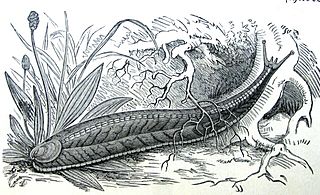
Testacella is genus of small to medium-large, predatory, air-breathing, land slugs.

Teinostoma is a genus of minute sea snails, marine gastropod mollusks or micromollusks in the family Teinostomatidae.
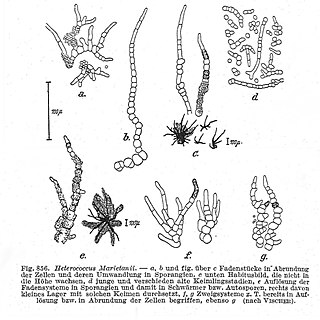
Heterococcus is a genus of yellow-green algae in the family Heteropediaceae.
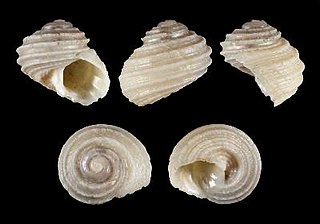
Homalopoma, common name the dwarf turbans, is a genus of mostly very small sea snails with a calcareous operculum, marine gastropoda molluscs in the subfamily Colloniinae of the family Colloniidae.

Sphaerexochus is a genus of trilobite from the Middle Ordovician to Late Silurian of Asia, Australia, Europe, and North America.
Tolpia is a genus of moths of the family Erebidae erected by Francis Walker in 1863. The genus used to be included in the family Noctuidae.

Colpodella is a genus of alveolates comprising 5 species, and two further possible species: They share all the synapomorphies of apicomplexans, but are free-living, rather than parasitic. Many members of this genus were previously assigned to a different genus - Spiromonas.

Pilina unguis is an extinct species of Paleozoic Silurian monoplacophoran. It was first named as Tryblidium unguis and described by Gustaf Lindström in Latin from the Silurian deposits of Gotland in Sweden, in 1880.

Pilina is an extinct genus of paleozoic monoplacophorans in the family Tryblidiidae.

Tryblidiidae is an extinct family of paleozoic monoplacophorans in the superfamily Tryblidioidea.

Astraea is a genus of medium to large sea snails, marine gastropod mollusks in the family Turbinidae, the turban snails.
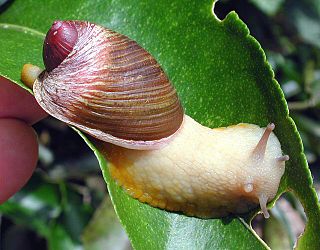
Amphibulima is a genus of air-breathing land snails, a terrestrial pulmonate gastropod mollusks in the family Amphibulimidae.
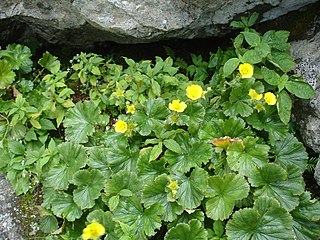
Geum radiatum is a rare species of flowering plant in the rose family known by the common names spreading avens, Appalachian avens, and cliff avens. It is native to the region of the border between Tennessee and North Carolina in the southeastern United States, where there are eleven known populations remaining. The plant was federally listed as an endangered species in 1990.
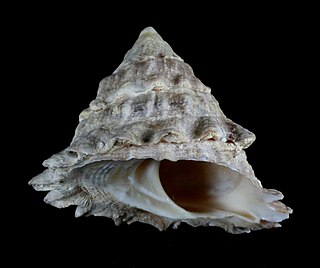
Uvanilla is a genus of sea snails, marine gastropod mollusks in the family Turbinidae, the turban snails.

Glyptagnostus reticulatus is a species of agnostid trilobite belonging to the genus Glyptagnostus. It existed during the Paibian Age of the Cambrian. It has a cosmopolitan distribution and is an important index fossil in biostratigraphy. It was characterized by an unusual net-like pattern of furrows on both the cephalon and the pygidium.
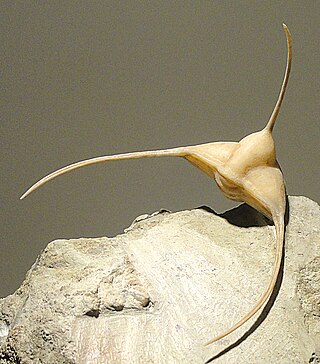
Raphiophoridae is a family of small to average-sized trilobites that first occurred at the start of the Ordovician and became extinct at the end of the Middle Silurian.
Aspergillus unguis is a species of fungus in the genus Aspergillus, and the asexual state (anamorph) of Emericella unguis. Aspergillus unguis is a filamentous soil-borne fungus found on decomposing plant matter and other moist substrates including with building materials and household dust. Aspergillus unguis occurs mainly in tropical and subtropical soils but has also been isolated from various marine and aquatic habitats. The species was first isolated in 1935 by Weill and L. Gaudin. Historically, A. unguis was assigned to the A. nidulans group, a common group of soil-borne fungi due to the resemblance of its ascospores and cleistothecia to those of Emericella nidulans. Aspergillus unguis is distinctive, however, in possessing spicular hyphae. A number of synonyms have been collapsed into this species, including Sterigmatocystis unguis, Aspergillus laokiashanensis and Aspergillus mellinus.

Omalonyx unguis is a species of air-breathing land snail, a terrestrial pulmonate gastropod mollusc in the family Succineidae, the amber snails.
















